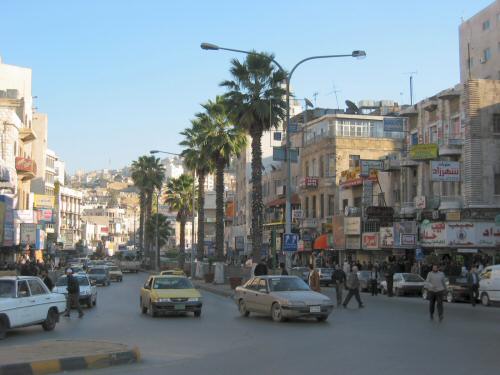Downtown Amman on:
[Wikipedia]
[Google]
[Amazon]
Downtown Amman ( ar, البلد, al-Balad) is an old, central commercial area of 

Amman
Amman (; ar, عَمَّان, ' ; Ammonite language, Ammonite: 𐤓𐤁𐤕 𐤏𐤌𐤍 ''Rabat ʻAmān'') is the capital and largest city of Jordan, and the country's economic, political, and cultural center. With a population of 4,061,150 a ...
, Jordan
Jordan ( ar, الأردن; tr. ' ), officially the Hashemite Kingdom of Jordan,; tr. ' is a country in Western Asia. It is situated at the crossroads of Asia, Africa, and Europe, within the Levant region, on the East Bank of the Jordan Rive ...
.

History
The Balad is the oldest section of the city. It is believed to have first been inhabited during theNeolithic
The Neolithic period, or New Stone Age, is an Old World archaeological period and the final division of the Stone Age. It saw the Neolithic Revolution, a wide-ranging set of developments that appear to have arisen independently in several parts ...
period (around 6500 B.C.). The seven ''jabals'' (hills) around it were occupied during the same time and formed the perimeter of the young city. The Amman Citadel
The Amman Citadel ( ar, جبل القلعة, Jabal Al-Qal'a) is an Archaeological site, archeological site at the center of downtown Amman, the capital of Jordan. The L-shaped hill is one of the seven hills (''jabals'') that originally made ...
sits atop Citadel Hill.
Markets in the Balad were trafficked by Ammanis of all stripes throughout most of the 20th century. This later changed; the area's commercial activity began to be referred to as "popular markets," connoting a perceived demographic shift in the kinds of people frequenting the markets. By the late 1960s and early 70s, the Balad was a topic of public debate, especially regarding public and private transportation options. Historically, the Balad's crossroads of public and shared transit routes (busses and shared cabs called "service") connected areas outside of central Amman with downtown and its neighboring hills, such as Jabal Weibdeh, Jabal Amman
Jabal Amman neighborhood is one of the seven hills that originally made up Amman, Jordan. Today, Jabal Amman is near the downtown area.
History
Along with the rest of old Amman, Jabal Amman was first settled during the Neolithic period. But unl ...
, Jabal Ashrafiyeh, and others. Various development projects were initiated by public and private actors which dramatically changed the character of the neighborhood in recent decades, even resulting in a general "decline in human presence" by the 2000s compared to previous eras.
Sites
Downtown Amman is made up of a myriad of ''souq'' markets and independently-owned businesses, including informal and marginalized economies. As described by anthropologist Ahmad Abu Khalil:"...within the area there is a concentration of the oldest central markets for vegetables, clothes, and secondhand clothes. The area is a core place for the informal commercial and service sector, via hundreds of street vendors (thousands during the peak time) and a specialized market for the Asian migrant workforce, especially on Friday. This is because it contains much of the secondhand business in Amman, especially that of the furniture sector."The Al Husseini Mosque is a major local landmark and can be said to divide the Balad into two (West and East). The area's long history, having been built up over ancient ruins, leaves a large number of historical sites, such as the nearby
Amman Citadel
The Amman Citadel ( ar, جبل القلعة, Jabal Al-Qal'a) is an Archaeological site, archeological site at the center of downtown Amman, the capital of Jordan. The L-shaped hill is one of the seven hills (''jabals'') that originally made ...
with the Umayyad Palace
The Umayyad Palace ( ar, القصر الأموي) is a large palatial complex from the Umayyad period, located on the Citadel Hill (Jabal al-Qal'a) of Amman, Jordan. Built during the first half of the 8th century, it is now largely ruined, w ...
, the Hashemite Plaza
The Hashemite Plaza is a plaza in Amman, Jordan that spans over an area of 20,000 square metres. It was renewed in 2014 and is named after the Jordanian royal family, the Hashemites.
The Hashemite Plaza includes open spaces, fountains, gardens, ...
with the Roman Theatre and the Odeon
Odeon may refer to:
Ancient Greek and Roman buildings
* Odeon (building), ancient Greek and Roman buildings built for singing exercises, musical shows and poetry competitions
* Odeon of Agrippa, Athens
* Odeon of Athens
* Odeon of Domitian, Rome
...
, and the Roman
Roman or Romans most often refers to:
*Rome, the capital city of Italy
*Ancient Rome, Roman civilization from 8th century BC to 5th century AD
*Roman people, the people of ancient Rome
*''Epistle to the Romans'', shortened to ''Romans'', a letter ...
Nymphaeum
A ''nymphaeum'' or ''nymphaion'' ( grc, νυμφαῖον), in ancient Greece and Rome, was a monument consecrated to the nymphs, especially those of springs.
These monuments were originally natural grottoes, which tradition assigned as habit ...
. New archaeological excavations are ongoing in 2020. Scholars reason that part of the draw to this location in ancient times was likely the proximity to the now mostly-dry Amman River
Amman (; ar, عَمَّان, ' ; Ammonite: 𐤓𐤁𐤕 𐤏𐤌𐤍 ''Rabat ʻAmān'') is the capital and largest city of Jordan, and the country's economic, political, and cultural center. With a population of 4,061,150 as of 2021, Amman i ...
.

See also
*Jabal Amman
Jabal Amman neighborhood is one of the seven hills that originally made up Amman, Jordan. Today, Jabal Amman is near the downtown area.
History
Along with the rest of old Amman, Jabal Amman was first settled during the Neolithic period. But unl ...
*Ras Al-Ein
Ras al-Ein ( ar, رأس العين; he, ראס אל-עין, ''lit.'' Head of the Spring) is a small Arab village in northern Israel, located in the Galilee, near the Tzalmon Stream. It falls under the jurisdiction of Misgav Regional Council. In ...
* The Roman Amphitheater
* Citadel Hill, Amman
References
{{reflist Amman